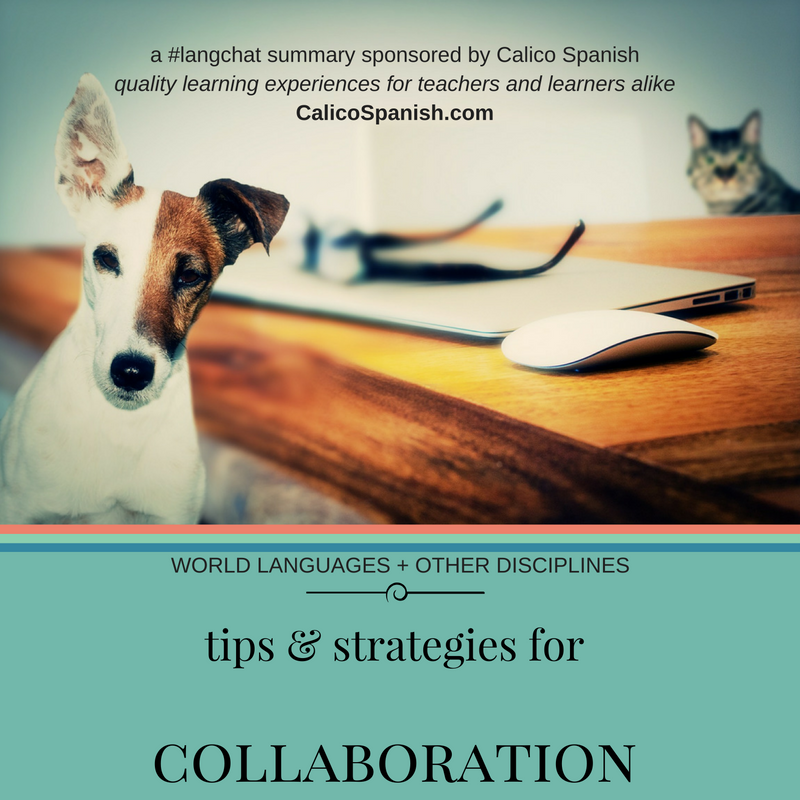How can World Language teachers collaborate with colleagues in other disciplines?
 Last week, #langchat decided to talk about ways for World Language teachers to be able to collaborate with their colleagues in other disciplines. Contributors discussed what topics of study in the WL classroom make for good opportunities for cross-disciplinary collaboration, and what things need to be in place to facilitate collaboration with other disciplines. Participants chatted through the finer points of how WL teachers can get their colleagues to want to collaborate, as well as the things that can be learned from observing non-WL colleagues (and vice-versa). And to finish up, they chatted through options for NON-curricular collaboration and how to make that work to your advantage in the WL classroom.
Last week, #langchat decided to talk about ways for World Language teachers to be able to collaborate with their colleagues in other disciplines. Contributors discussed what topics of study in the WL classroom make for good opportunities for cross-disciplinary collaboration, and what things need to be in place to facilitate collaboration with other disciplines. Participants chatted through the finer points of how WL teachers can get their colleagues to want to collaborate, as well as the things that can be learned from observing non-WL colleagues (and vice-versa). And to finish up, they chatted through options for NON-curricular collaboration and how to make that work to your advantage in the WL classroom.
Question 1: What topics of study make for good opportunities for cross-disciplinary collaboration?
The World Language classroom may be a new world for students but basically every topic that’s covered in the target language can lend itself to collaboration with other disciplines if done in the right way. Some of the topics that chatters agreed make for excellent collaborative opportunities included things like studying politics of the target culture, ecotourism, history and literature, music and art, culinary arts to make TL cuisine, food unit with nutrition health/science, computer science for presentations, and many more.
@MaCristinaRV had a great point when she said, “I believe language can be used & connected with any other discipline. You can always make a connection with authentic communication!” and @MarciHarrisAA agreed saying, “All units in WL can be connected to other disciplines through music, art, literature, biographies, math, technology, & science.”

When teachers in different disciplines have a clear plan, collaboration creates a perfect fit!
Basically, any topic in the WL classroom can be applied to cross-disciplinary collaboration as long as there is willingness on both sides to communicate and work together.
Question 2: What needs to be there to facilitate collaboration with other disciplines?
Before collaboration with other disciplines can take place, there have to be some things built-in ahead of time in order to facilitate the collaboration process. The main ideas for what processes need to be in place included the time to come up with the project, the resources to make it happen, the actual desire from other educator’s to participate in collaboration, a common interest between teachers of various subjects, clear expectations from both groups of hoped for outcomes, and a common meeting point in both curricula where the collaboration makes sense for everyone.
@ProfeCochran explained the necessary pre-collaboration process beautifully:
Start with the end product- what is the goal? Then [figure out] how do we scaffold to make sure both subjects get what they need [to make it happen].
Similarly, @aacpwcls put it very succinctly when they said there has to be a “willingness to work together, review curriculum standards, desired outcomes and serious planning” between teachers or cross-collaboration just won’t be possible.
Question 3: How do we get our colleagues to want to collaborate with us?
The sticking point for many WL teachers that keeps them from trying for cross-collaboration is that other teachers don’t seem to be interested in participating. So langchatters jumped in with some great ideas for how to actually get colleagues to want to collaborate, and ways to do so included offering to teach their content/showing interest in their subject, ask lots of questions about how they do what they do, show respect for their work/enthusiasm for being a part of it, selling the idea that together you’re stronger than you are individually, make it apparent that it won’t be “more work” for them, remind them that the purpose is to help reinforce both sets of content, point out the similarities in your curriculum topics, and lots more.
@joyeuse212 summed the answer for this question up when she said, “Show [them] how collaboration on that particular topic can benefit both students & the curriculum.” and @SraDentlinger agreed saying, “Remind them [that collaboration] is really good for the students. Everything should be about what’s best for students!”

For a fresh perspective on your own craft, take a closer look at your colleagues in other disciplines!
Langchatters really agreed on the point that if there’s a subject/teacher collaboration that you can see will benefit everyone, there’s a whole lot of tools in your arsenal to help your colleague see how and why it would be good for them too. Just remember to be patient and keep working at it because the first time you ask might not work but if you really want to make it happen, you can!
Question 4: What can we learn from observing our non-WL colleagues and vice-versa?
Getting teaching tips from other teachers within the WL department might seem like the easiest/most sensible thing to do when you need help, but often times it can be getting a completely outside perspective that really pushes you to the next level in your WL classroom. Great things to learn from observing non-WL colleagues (and vice-versa) included classroom management/organization techniques, new ways to deliver material, how they have students collaborate with each other, as well as technology tricks to help up student interest/participations.
An interesting point came from @SraDentlinger who pointed out that her, “…favorite thing to observe with other [teachers] is how the kids are in their room. [You] learn a LOT about [your] own students” (which in turn can help you learn new ways to work with/around your students to make your classroom structure work better for you in the long-run).
And last but not least, several teachers shared variations on the fact that you learn how much their classroom dynamics vary from the WL environment, which lets you understand/accept those differences and figure out how to make that work to your advantage. As @ProfeCochran put it,
90% of everything I do, I learned from a teacher of a different content area.
Question 5: We’ve touched on it already, what about NON-curricular collaboration?
To finish up, langchatters quickly talked about non-curricular collaboration ideas, which included things like community outreach, the “hidden” curriculum of creating a positive learning environment, collaborating on a school event/project that’s not tied to a class, service-based learning, multicultural nights, dual language poetry contest/night, coaching, sponsoring, mentoring, advising, and chaperoning.
Takeaways
This week, langchatters took on the topic of cross-collaboration with colleagues in other disciplines and had some great ideas for how to make it work to everyone’s advantage. The main takeaways from the conversation centered on ideas like the fact that every teacher (regardless of language) needs to work in more collaboration into their curriculum, it’s important to push past one’s one comfort zone to help empower/expand your student’s experience, that collaboration should be encouraged inside AND outside of the classroom since it builds community, and the fact that collaboration is what makes “school” effective in the first place.
@magisterb480 summed up the overall takeaway of the cross-collaboration conversation when he said, “Collaboration with teachers in every discipline is important for creating a more well-rounded education for all students.
Thank You!
Thank you Kris (@KrisClimer), Bethanie (@lovemysummer) and Meredith (@PRHSspanish) for leading this week’s chat, and as always, thanks to everyone who takes the time to join these discussions every week. We hope that you continue to link up with #langchat as often as you are able – if the weekday chats on Thursday evenings at 8 p.m. ET don’t work for you, try joining the #SaturdaySequel, every Saturday morning at 10 a.m. ET instead!
Our weekly #langchats have gotten busier and busier, so due to space limitations, the summaries always focus on the main themes and takeaways from each week’s conversation. Many tweets have to be omitted but to read the entire conversation from this week, you can access the full transcript on our tweet archive. Have a topic that you’re impatient to discuss?! Send us your ideas for future #langchats!




No Comments